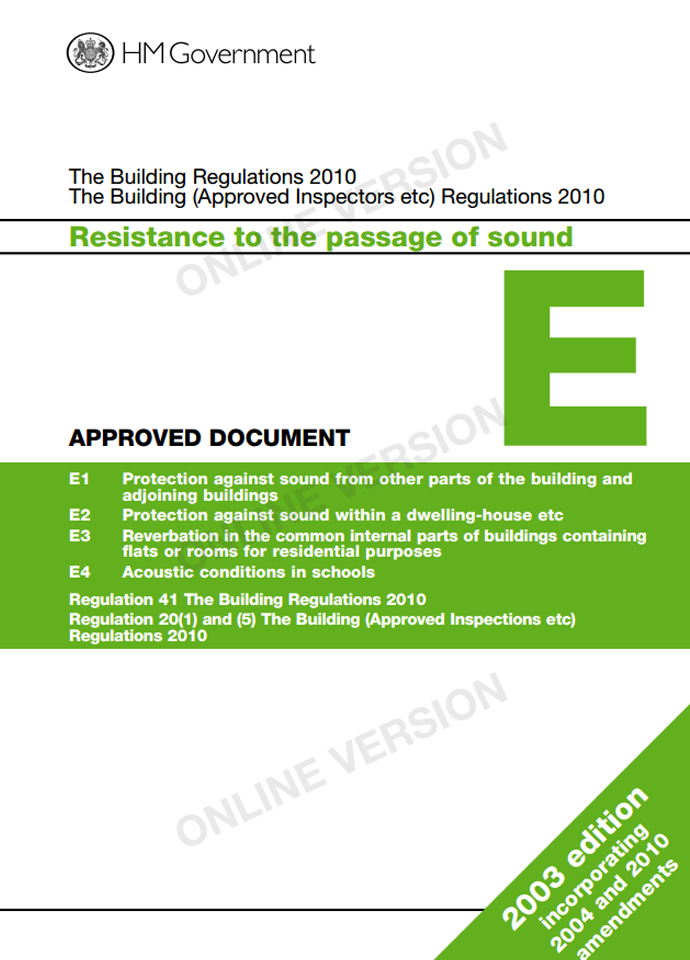Offices Nationwide

Sound Intensity
Sound intensity's measured in Decibels (dB). An logarithmic scale where an increase of 10 dB gives an apparent doubling of loudness...more

Environmental Noise Levels
The max exposure time at 85 dBA is 8 hours, at 110 dBA it's just 1 min 29 seconds. If exposed, limit the time and wear hearing protection...more
Part E
Resistance of the Passage of Sound

Air Testing is sometimes referred to as Domestic Air pressure tests, Domestic Air tightness tests, Domestic Air tests, Domestic Air pressure testing, Domestic Air tightness testing, Domestic Air leakage testing.
Air Leaking Testing Across the UK
How Many Properties Need An Air Tightness Test?
The number of tests required are as follows:
- 4 or less properties of the same type: one test needed per type
- More than 4 but less than 40 dwellings of a type: at least two tests of each type
- More than 40 properties of a type: 5% of each type UNLESS the first 5 get a passing score - then this can be dropped to just 2%
Why E2 Consultants?
For a quote or for more information, call our air tightness / pressure testing consultants in the UK on 0800 043 8100 or email us on @e2consultants.co.uk
E2 Consultants offer a range of services from desktop reviews of drawings to pre test inspections on site to advice on air tightness, how to improve and what needs to be completed and sealed for the testing to take place successfully.
All new buildings in England and Wales have had a mandatory requirement since 2006 (2010 in Scotland) that domestic and commercial buildings, must have a passing air leakage certificate before the property can be passed off by building regulations.
At E2 Consultants we offer Air Leakage Testing throughout the UK and surrounding areas. Our experienced air leakage testing consultants will also be happy to offer advice on the best ways to gain your target rating.
What Does An Air Leakage Test in the UK Involve?
Whilst the air tightness test is being undertaken, furniture will not be affected but smaller items such as paper must be held down or removed completely so they're not blown about. The pressure of the room will be tested and as such all windows and doors that lead outside must be securely closed to avoid them swinging open and the test being abandoned. Similarly, all internal doors should be wedged open to avoid being slammed shut.
Employees can still do their job inside a commercial or domestic building in the UK whilst the air test is being carried out, within reason, though may feel some discomfort due to the noise of the fan and the draught that will be felt throughout the building. There should be no outside access once the test has begun - which lasts for approximately 90 minutes, so plan accordingly.
Air tests cannot be carried out if the wind speed is more than 13mph - 3 metres per second is the ideal wind speed when undertaking an air test in the UK. An air test involves placing a large fan, or several fans, to an opening within the property; usually a doorway. The fans will increase and decrease in speed that will in-turn change the building's air pressure and record the results.
What Air Permeability Rating Do I Need?
The air tightness rating of a property is not a fixed figure. This is set by the design SAP Calculation carried out (please contact us if you also require a SAP Calculation in the UK ). However the worst acceptable standard for air tightness is 10 m³/(h.m²) which resembles the amount of uncontrolled air that's leaking from the dwelling. However this does not mean that it would pass the SAP Calculations Design Air Permeability standard. Should the test fail, our air tightness team will help you identify where the leakages are happening in the hope that a passing score will be achieved after a re-test.
When Should The Test Take Place?
A building envelope will need to be completed before the air test takes place - which should be one of the last surveys undertaken once all the walls, windows, doors etc. are complete and sealed. This ensures no air will escape and prevent drafts through the property which will in-turn improve your air permeability score.
Warning: count(): Parameter must be an array or an object that implements Countable in /data04/elite/public_html/Office.php on line 755
For further Domestic-Air-Testing information for your area, be sure to check out Air-Testing-.co.uk.
Our other services include:
Warning: Invalid argument supplied for foreach() in /data04/elite/public_html/Office.php on line 769
Domestic Air Testing can also be known as:
Air Testing, Domestic Air Leakage Testing, House Leakage Testing, Fan Pressure Testing, Domestic Air Integrity Testing, Domestic House Leakage Testing, Air Integrity Testing, Air Leakage Testing, Domestic Air Tightness Testing, Domestic Air Pressure Testing, Air Tightness Testing, Air Pressure Testing, Domestic Fan Pressure Testing,
Copyright 2025 E2 Specialist Consultants Limited
Company No. 06728970






































